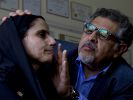Eye For Film >> Movies >> Saving Face (2011) Film Review
There was a collective gasp of horror when Zakia removed her veil to reveal the full extent of the damage to her face: one side of her face, including her eye, completely destroyed. This Oscar winning film must be one of the most harrowing shown at Sheffield's Doc/Fest. Zakia is a survivor of acid attack, which has become appallingly common in some parts of the world, mainly Cambodia, Afghanistan and Southern Asia.
This documentary focuses on Pakistan, which has around 100 reported cases per year, while it is thought many more, especially in rural areas, go unreported.

Acid attacks are made on men and children, but mainly on women, often by their husbands, sometimes for rejecting a proposal or resisting harassment. Of the women who bravely speak to camera at the beginning of the film, one is a 13 year old girl who rejected the advances of her teacher.
Zakia was attacked by her husband when she filed for divorce after years of abuse. Rukhsana was attacked by her husband, then her sister-in-law and mother-in -law, who set fire to her and locked her in a room to die. She survived, but was forced to go on living with them because she had nowhere else to go with her children. They have since taken her daughter from her. She is pregnant and hopes it will be a boy because girls suffer so much.
The film follows the stories of these two women and their fight for justice.
For many of Pakistan's acid attack victims, hope lies with Dr. Mohammad Jawad, a consultant plastic surgeon with a practice in London who came to prominence after reconstructing the face of Katie Piper. His larger than life presence provides the film with a strong narrative thread. Born in Pakistan, he says “In a way I'm saving my own face because I'm part of this society.”
He shows deep compassion for the women he interviews and helps with surgery. But he also gets a kick out of what he does. In the operating theatre he says “I'm having a party. I'm restoring someone's life.”
The women who suffer these attacks lose more than their looks. Scar tissue means that, without surgery, they often become unable to eat or breathe properly. There is great psychological trauma as they can't believe that in an instant their lives are changed forever. On top of this is the social ostracism, which affects the whole family. The women are condemned to a life indoors because relatives are shamed by their appearance. Zakia's daughter complains that instead of sympathising, her schoolmates shun her.
Despite this, some of these women are brave enough to act, Zakia pursuing a court case against her husband, Rukhsana joining women who are campaigning for a new law. They are supported by the Acid Survivors Foundation, which has had some success in drawing doctors such as Jawad to perform surgery and also offers a save haven for some, where they gain confidence by meeting other survivors.
This foundation employs a worker who goes out into the countryside seeking out cases which would otherwise be hidden. He explains that acid is easy to obtain because it is used extensively in cotton farming. This and a lack of prosecution has led to an escalation in this horrific crime.
There are a few scenes in the film, such as one where Zakia sits talking with her daughter, which are too obviously set up for exposition, and this rather weakens it. The drama as Zakia waits to hear the verdict on her husband is rather contrived. But most of the additional information is given in short captions between scenes, not distracting from the compelling interviews and action.
This is a deserving Oscar winner and I urge you to see it. Many of the mostly young audience here seemed shaken by it and some said afterwards that they had felt deeply angry all the time they were watching.
For more information, visit the website of the Acid Survivors Foundation.
Reviewed on: 15 Jun 2012
















